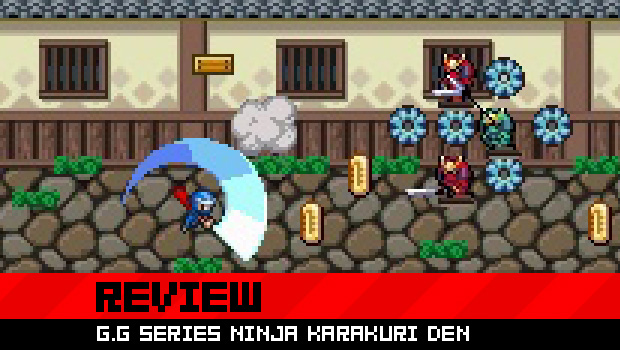Japan can be a real ball hog sometimes. A bazillion awesome-looking games come out each year, yet only a handful get localized. Don’t even get me started on the surplus of legacy software that appears on their download services! Is it fair that Japan gets 14 PSOne Classics a week while we only get one every other blue moon? Why must we go through the hassle of tricking our consoles’ region settings to play games that did, in fact, hit Western retail?
The G.G Series is a collection of such Japan-exclusive downloads for DSiWare. For 200 points a piece, these games are snack-sized distractions that range in quality from decent to poo-poo. A set of 30 was eventually bundled onto a DS cart, and word on the street is that this collection seems to be the best way to experience them.
Publisher Genterprise recently announced plans to localize a couple of G.G titles, Ninja Karakuri Den and Super Hero Ogre, with the possibility of more in the future. The former was just released this past Monday, so I decided to give it a whirl and see where on the infamous G.G quality spectrum it falls.
G.G Series Ninja Karakuri Den (DSiWare)
Developer: Suzak
Publisher: Genterprise
Released: August 23, 2010
MSRP: 200 Nintendo DSi Points
Okay, so it’s not terrible.
Ninja Karakuri Den is an arcade-style platformer with a visual aesthetic akin to Ninja JaJaMaru-kun on the Famicom or Haggleman from the recent Retro Game Challenge. Each level is a single-screen “room” that must be cleared of all gears in order to reveal an exit door. The nameless hero ninja must constantly jump off of tiles that then fall away, making levels more perilous with each passing second.
Also populating levels are enemy samurai that come in three flavors — short-range katana wielders, medium-range spear thrusters, and long-range gunners. Your ninja is invincible save for falling into pits, so enemy attacks merely halt your momentum or send you reeling backwards. While this is a minor annoyance in the early levels, it becomes an issue further in as fewer tiles populate the room.
New tiles materialize in random spots at regular intervals as long as there’s time left on the timer. Sometimes, a missed jump or enemy collision can be rectified by a lucky appearance of a tile beneath you. However, once time expires, tiles stop forming and the background turns pitch black, an indication that you should hurry up and find the goal.

Jumping is performed automatically, but jump height can be controlled by pressing up or down on the D-pad. You can attack across distances using an endless supply of rather ineffective shurikens or up close with katana slashes that kill enemies in one hit. A dash technique for clearing long gaps can normally be used once per jump, and combining a dash with a slash produces a more powerful attack that can drill through a row of samurai as well as destroy gears in one slash instead of the normal two.
Level progression follows a regular pattern — three standard stages, a boss battle, then a coin-collecting bonus stage. The boss stages pit you against enemy ninjas of increasing skill who jump from wall to wall tossing shurikens at you. For the first few encounters, you’ll face lowly apprentices, but later you’ll challenge adepts who drop bombs in their path and masters who can create shadow clones.

There are 60 levels in total, each level lasting 30 seconds at most. If you lose a life, you’ll restart the current stage minus the gears you’ve already destroyed. If you exhaust all your lives, you’ll restart the current level with all the gears back in place and a reset score counter. With little in the way of punishment for failure, you can breeze through the entire game in less than half an hour.
Even considering the short playtime, the game manages to skimp on variety. You meet all the enemy types by the 11th level and encounter the same three ninja bosses four times apiece. Instead of a thrilling final battle, the game ends on an anticlimactic note with another non-threatening bonus room. This is the kind of game that could have welcomed replays with randomly generated maps, but as it stands, there’s no reason to return other than to record how far you can travel without continuing.
If I assume that this is one of the better G.G Series titles, my earlier suspicions that these games are better suited for a collection format are justified. Ninja Karakuri Den is too short and suffers from a dearth of content, yet it’s enjoyable and cheap enough to just barely, barely, squeak by with a recommendation.


